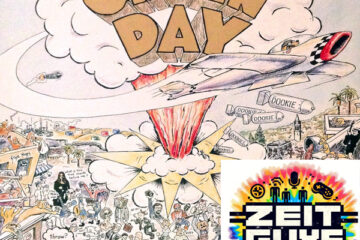America: An Illusion by Faiza Khaled
Throughout history, the flaws of America have been glamorized, creating a facade of America’s true image. America can be viewed through different lenses, each of which suggest a unique perspective of what America truly is. These perspectives can be viewed in the form of economic prosperity, immigrants and labor, and imperialism. All these lenses put together create America, an illusion.
In America, economic success serves as an emblem of the country’s overall superiority. In F. Scott Fitzgerald’s, The Great Gatsby, the theme of wealth materializes the lavish American lifestyle that can be achieved through money. Fitzgerald creates a juxtaposition between wealth and the means it is acquired through the idea of “old money” and “new money.” The concept of new money defines true wealth to be gained through individual work and diligence rather than having “old money” be handed down generationally. Representing “new money” in America, inventors of the Gilded Age like Thomas Edison, Henry Ford, and Alexander Graham Bell, advanced America technologically and gained immense profit for the economy in the process.
Inventions like electricity, automobiles, and telephones spurred immense profits through investments and the rise of a capitalistic economy. Newly stimulated economic growth encouraged rapid industrialization throughout the whole country and within various groups of people as well. Especially amongst minority groups like African Americans, industrialism serve as a means to prove their worth and value. In Booker T. Washington’s, “Atlanta Compromise” speech, he encourages the elevation of the Black race to be achieved through economic and industrial contributions. Washington acknowledges the “extrem[e] folly,” of desiring social equality and instead encourages African Americans to utilize their newfound opportunities and skills for the better of the greater good through industry and economy. Instead of romanticizing their freedom for pleasure, he reminds all his people to “prosper in proportion,” and differentiate “between the superficial and the substantial.” Washington addresses the African Americans by emphasizing that labor work is just as valuable and dignified as something glamourized like “writing a poem.” Instead of immediately fighting for social equality, they must first contribute to improving the whole economy of the south. By playing a vital role in the development of society, they prove the value of their race and therefore gain a better chance in gaining equality. The process of industrial labor not only contributed to “all things essential to mutual progress,” but simultaneously stimulated social justice in a nonviolent way. The newfound economic prosperity, gained through innovative means, creates the prosperous nation that we call the “Land of Opportunity.”
With a similar mindset of gaining American opportunities, many Chinese laborers immigrated to the United States. In 1849, an influx of Chinese immigrants arrived on the West Coast of the US as a result of the California Gold rush. Due to the rapid growth of the Chinese workers, competition arose between the white Americans and Chinese for jobs. In 1882, the Chinese Exclusion Act was passed, prohibiting Chinese immigrants from entering the US for a decade. The stigmatized influx of laborers resulted in a series of anti-Chinese riots and discrimination. Aside from the Chinese laborers, many poor laborers were also forced to work under harsh and hazardous conditions. Especially with children, laborers had to work in dangerous settings like unprotected factories and mines with little to no pay. Children had to work in unclean environments factories with no safety regulations in place. Impoverished children were forced to work in these conditions with a less than substantial pay. Even adults lacked a safe working environment and a reasonable wage. This spurred the creation of labor unions and promoted strikes. The Knights of Labor, the American Federation of Labor, and the International Workers of the World (IWW), were some of the many organizations that promoted 8- hour workdays, abolition of child labor, striking, and gave the power to the workers. The illustration, “The Hand That Will Rule the World” by Ralph Chaplain, portrays the unity of workers coming together in solidarity as they hold the tools they work with in one hand, and the other fist coming together as one. The illustration is meant to promote the message of the IWW, which gives the workers control over the industry, something that they lacked to begin with.
Although economic prosperity is viewed as a means to show the superiority of the nation, the harsh reality behind the process of success is not as glorified as the innovative and profitable developments are. America’s glamorized economic success came at the expense of the human rights of labor workers.
Economy symbolizes a major source of superiority for America, but in the late 1800’s, Imperialism emerged as the most significant representation of America’s true power, especially towards the perspective of other imperialist nations like Germany, Great Britain, and France. “School Begins,” a political cartoon by Louis Dalrymple, illustrates the new territories of Cuba, Philippines, Puerto Rico, and Hawaii being taught by America, portrayed by Uncle Sam, how to properly be American by abandoning their traditional and cultural lifestyle and westernizing themselves in order to fit into America. In the back, older territories like Texas and New Mexico are sitting in a civilized manner which is meant to represent the model for what America hopes to create out of the newer territories. The political cartoon represents the “White Man’s Burden” mindset possessed by Americans as they attempt to expand imperialistically. “White Man’s Burden” is the ideology that it is the responsibility of white colonizers to take control and govern a country in order for the country to prosper until “they can govern themselves.” The burden concept was used as a means to justify the rapid conquering of small nations by bigger colonial powers like America. Similarly in the political cartoon, “Declined with Thanks,” America is also depicted by Uncle Sam but in an expanded and enlarged manner. Due to the rapid expansion,
President McKinley is tailoring more fabric for Uncle Sam while endorsing the idea of imperialism. He uses fabric labeled as “enlightened” and “rational expansion.” In a sense this shows the idea of American superiority by stating that America is expanding in a rational and deserving manner although it is no different from other countries like European expansion. It can also be interpreted as another example of “White Man’s Burden.” By conquering smaller territories and nations, America rationalizes the conquering through a sense of responsibility.
America justifies taking over smaller and weaker territories by saying that it is America’s responsibility to take over the nations in order for the nation to survive and prosper. Using this justification, America began conquering many individual nations to expand and flaunt their power, creating an image of powerful domination.
Even dating before the 1850s, America was viewed in diverse ways by various people and nations. From the 1850s to 1930s, the raw and flawed reality of America was masked by economic affluence and imperial expansion. The process behind America’s successful economy and rationalization of imperialism was a perspective only held by those who experienced it first- hand like the immigrants and small conquered territories, while on the exterior presented
America to be superior. Principles of wealth and power serve as the cataracts of America’s authenticity. (1,190)
America: A Double Sided Coin by Bell McKee
In 1850s to 1930s, the United States of America was still a young nation. In the process of trying to sort things out, an American identity began to surface. Even today, being American has many facets. During the 1850s to 1930s America was priding itself on being for the people, but the government can be easily tied to numerous conspiracies and conquering tendencies.
America continues to be for the people however, during 1850-1930 people were still establishing what it meant to be American and how America could be for the people. A major issue facing America was her labor force. As Madison Horne writes on History.com, the number of kids in the workforce “had grown from 1.5 million in 1890 to 2 million” in
1904 (Horne). Congress however did try to help this “by passing the Keating-Owns Act” in 1916 (Horne). Although it would not be until the Great Depression that the view on child labor really saw a shift, groups such as the National Child Labor Committee (NCLC) helped to catalyze change for the better. Organizations such as the NCLC helped to shed light on the conditions the children serving as the backbone of industrial America were working in. Photographers such as Lewis Hines were influential in doing this. While change may have been slow, they were present and in motion. Another manner in which America was trying to be a nation for her people was by forming associations such as the Food and Drug Administration (FDA). Following the work of Upton Sinclair’s The Jungle, many concerns were raised for the sanity of the food people were consuming that led to the formation of the FDA. Workers in food factories were being subjected to harsh chemicals, dangerous tools, and toxic air conditions on the dailey, but no change was being made until Sinclair put these working conditions on the radar of the public. Both Lewis Hines’ and Upton Sinclair’s work helped to make Industrial America safer for workers. Since America is a nation built on capitalism and the economy, without these two men, America’s workforce and economy would be in shambles. Upton Sinclair’s The Jungle also helped to shed light on the deception of major corporations.
While America seems great at the surface, a further look reveals some questionable actions. Upton Sinclair includes in The Jungle that the “visitor tours” did not actually encapsulate the true factory and worker conditions. Sinclair goes so far as to say that “these people could not be shown to the visitor” because of their stench alone (Sinclair, 298). Among other things, these factories were lying about the contents of “sausage” and the difference between the regular and “smoked” sausage.
Although the facade presented by the food factories came to an end with the FDA, there are government actions that present a similar level of peculiarity and suspicion. One of these actions is the “The Zimmerman Telegram,” a telegram from the British to America that included a supposedly intercepted and decoded telegram from the Germans. During World War I, the United States had managed to stay out of the conflict. That was until the British informed us of a German telegram they had supposedly intercepted. In the telegram in question, the Germans request the Mexicans engage with America on their behalf with a mutual understanding on the “following basis: make war together, make peace together, generous financial support and an understanding on [the German’s] part that Mexico is to reconquer the lost territory in Texas, New Mexico, and Arizona” (German Foreign Office and British Foreign Communications, 310). What is strange is that Mexico had just gone through a period of turmoil after fighting for its freedom then a civil war putting the Mexicans in no position to fight in any type of war. The United States knew this but still took the British’s “German” telegram as a threat because the fact of the matter is America was looking for a way into the war. The British were looking to relieve the pressure building in Europe and so formulated “The Zimmerman” telegram as a means to bring a willing America in. An almost too perfect scheme that, alongside the fact that the documents were classified until the 1960s, looks to be only an excuse to join a war. While America may have many conspiracies surrounding her, she also has some empirical characteristics that require addressing.
America’s desire to expand had many pros and cons to it. Westward expansion allowed for more jobs and gave people a chance to start over. Harvey Dunn’s “Prairie Is My Garden” perfectly encapsulates everything good that the United State’s expansion stood for. Featuring a mother and her two daughters, there is nothing but their homestead, endless fields, and blue skies to be seen. The mother and her daughters pick flowers, symbolizing that these women had the time to leisurely pick flowers. Having the time to pick flowers shows the laid back goal of Westward Expansion. Being that the painting only has women also plays into the growing feminism which sought to make life better for women. Out West, women could own property and that is exactly what this mom is doing. No fences hold her and her daughters back giving the feeling that anything is possible out West. However, there is a negative side to the greatness of expansion. Louis Dalrymple’s political cartoon “School Begins” encapsulates the negatives of the U.S.’s desire to constantly expand. Chinese, Black, and Native American students are all positioned to show the U.S.’s neglect towards her already established minorities. Native’s are one of these existing minority groups who can relate to the newest members to America: Cuban, Puerto Rican, Hawaiian, and Philippian. All of these groups relate on one front, they have had their land stolen or conquered by America. The Age of Imperialism is long since over, yet Americans were continuing to take land and expand in what can only be described as an empire’s mindset. This Empire mindset had been outdated when the Age of Imperialism ended, but can be seen again with a resurgence of White Man’s Burden used to justify America’s colonization of these people. White Man’s Burden is the belief that it is the White Man’s job, or burden, to civilize other “savage” groups. These “savage” groups were, in reality, just the targeted minorities who inhabited the land the White Man was looking to obtain.
Seating the Cuban, Puerto Rican, Hawaiian, and Philippian students at the front aligns with this idea and Dalrymple’s composition of the piece only helps to strongly emphasize how Uncle Sam was the bad guy here.
While the United States is a new nation and continues to grow and improve to this very day, there is no denying the negative sides to many of her positives and the negative history associated with many of her modern aspects.


